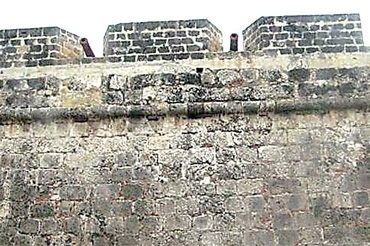Cartagena, Colombia
where hope trumps despair

Franklin W Knight |
THE port city of Cartagena
on the rugged Caribbean coast of Colombia has more
lives than a proverbial cat. It is a wonderfully fascinating
place where hope has repeatedly trumped despair. In
this charmingly historic city the people have repeatedly
manifested a strong resilience as well as a determined
political will not only to survive but also to succeed.
Cartagena has had the sort of up-and-down history
that ought to resonate strongly wherever violence
and inept government seem to be the order of the day.
Cartagena may stay knocked down for a long time. But
it never stays down forever; and it never gives up.
A sound moral emerges from the challenging experience
of the people of Cartagena. It is that nothing lasts
forever.
|
Reconstructed 11-km Cartagena city wall
invincible in the 18th century. (Photo: Franklin W Knight)

Cartagena was founded in 1553 during the
Spanish expansion in their desperate search for gold and
other precious commercial commodities. A civil war was still
raging among the conquistadores in upper Peru. With an excellent
sheltered harbour and abundant supplies of fresh water from
the nearby Magdalena River, the location proved irresistibly
attractive. So Pedro de Heredia started a modest settlement
that grew in fits and starts. When the wars ended Cartagena
became an important nodal point along the route that linked
the wealth of Peru to Havana and Spain. From Peru and the
interior of Colombia came copious quantities of silver and
gold for trans-shipment to Spain. In the other direction
flowed African slaves to do the multiple manual tasks required
in colonial construction and development. More and more
merchants arrived to carry on legal and illegal trade. Even
the Office of the Inquisition established a branch in Cartagena
to make sure that material prosperity did not undermine
religious orthodoxy.
Wealth attracted pirates, nasty fellows
like Jean-François Roberval, Martin Cote, John Hawkins
and Francis Drake. It also elicited the envious attention
of rival European monarchs. Pirates and kings made life
rough for the locals. Foreigners repeatedly sacked and burned
the city. After each disaster the citizens patiently rebuilt
their town, adding to its walls and fortifications and paying
increasingly greater attention to its defensive needs. In
1697 Louis XIV sent Bernard Desjean and Jean Baptiste Ducasse,
names familiar in Caribbean history, to capture the town.
They failed. In 1741 during the War of Jenkins Ear, Admiral
Edward Vernon besieged the city with a fleet of 186 ships
and 23,600 men, largely recruited in the northern colonies.
Among the recruits was Lawrence Washington, the half-brother
of George Washington. The mission was a disaster. Nevertheless,
young Washington was so taken with Vernon that he named
his Virginia estate on the Potomac River in his honour.
By 1756 when the Seven Years War started,
Cartagena was the most impregnable city anywhere in the
Americas. It had eleven kilometres of sturdy walls with
castles and sentry boxes, adequate storage facilities for
food and weapons, as well as an intricate network of underground
tunnels connecting the principal defensive positions. The
Spanish viceroys moved their residence from Bogotá
to Cartagena, reflecting the new status of the city. But
the days of glory were relatively brief. With the outbreak
of political independence after 1811, things started to
fall apart rapidly.
The history of Cartagena after independence
parallels the larger history of modern Colombia. Both have
been woeful experiences of interrupted tragedy. At independence
Cartagena had a population of nearly 30,000 inhabitants.
By 1842 the population had fallen to slightly more than
4,000 in a city marked by abandonment and disrepair. Cartagena
suffered like the rest of the country in the successive
waves of violence that engulfed the country like the War
of a Thousand Days between 1899 and 1903. At the end of
the First World War the population was only a bit more than
it had been at the time of independence.
The population slowly recovered in the
early 20th century. Then the prolonged destructive period
of civil war between 1946 and 1957 shattered city and country.
It was the lowest point of despair for the people of Colombia
and especially for those in Cartagena. But in 1957 the two
contending political parties, the Conservatives and the
Liberals, negotiated a period of national unity that lasted
until 1978.
The national unity government allowed
municipalities throughout the country to develop local plans
for regeneration. Bogotá concentrated on government,
expanding its bureaucracy as far away as the islands of
San Andres and Providencia. Santa Marta capitalised on the
fact that Simón Bolívar, the founder of the
nation, died there. San Pedro Alejandrino, the attractive
suburban farmhouse where Bolívar died, failed to
become a secular shrine comparable to Santiago de Compostela
or Lourdes. Barranquilla placed its bet on medical services
with surprisingly successful results. Medellín and
Cali opted for extra-legal international activities that
brought private fortunes and universal infamy.
Cartagena exploited its location and its
history, becoming one of the earliest and most successful
attempts at what later became heritage tourism. In the 1950s
the city fathers started to restore the former architectural
splendour of their city, carefully rebuilding the walls
as well as the many convents, churches, public and private
residences. It was a slow, costly process that paid off
in 1984 when UNESCO declared the city a World Heritage Site.
Although the nearby beaches were not as beautiful as those
of Rodadero and Tayrona near Santa Marta, Cartagena built
hotels along the spit of land called the Bocadero between
the harbour and the sea offering an affordable destination
for affluent Colombians. Local tourism eventually appealed
to foreigners and boosted the fortunes of the city.
Today Cartagena is the fifth largest populated
city in Colombia, with more than 1.2 million inhabitants
and a Mecca for national and international tourism. Pulling
back from an abyss is difficult but not impossible. In that
Cartagena provides an exemplary case study.
|

